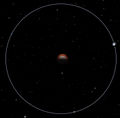Duna
Duna is the fourth planet of the Kerbol star system. It is the Mars analog for Kerbal Space Program and is mostly red with polar icecaps. It has one natural satellite, the moon Ike. Due to Ike's size and proximity, Ike and Duna are tidally locked to each other.
With proper aerobraking, a round trip from Kerbin to Duna's orbit and back requires roughly 1700 m/s of delta-v, less than a round trip to any other planet.
Contents
Topography
|
Duna's terrain ranges in altitude from 0 to 4662 meters. Its mountainous ranges are a peril to landing craft, especially considering the thin atmosphere, where very little aerobraking can be done safely. Duna's icy poles are quite expansive and are the result of a thin atmosphere. There are several maria (large regions of dark soil) at exactly 0 meters altitude. These are excellent landing locations due to their flatness and their low altitude, which allows for more aerobraking. There seem to be many craters on Duna's surface, sugesting that the aerobraking isn't the most efficient option. Duna's surface contains anomolous features, including a rock face similar to the one seen in early satellite images of Mars. |
Atmosphere
|
Duna's atmosphere begins at 41,446 m. It is only 20% as dense as Kerbin's at altitude 0 and is even less dense (relative to Kerbin) at higher altitudes. This effect becomes especially noticeable at Duna's highest points, where its atmosphere is only 21% as dense as its atmosphere at altitude 0. (For comparison, on Kerbin, the atmosphere at the highest peaks is 45% as thick as at sea level.) When landing on Duna, aerobraking can reduce orbital and surface velocity greatly, saving fuel. For best results, an aerobraking maneuver should maximize time spent in the atmosphere by entering at a shallow angle and aiming for a landing location in a low-lying area. Like all atmospheres in the game, Duna's atmosphere fades exponentially with increasing altitude (with a scale height of 3000 m). In general, the atmospheric pressure on Duna at an altitude expressed in meters is:[1] Parachutes work at lower efficiency than on Kerbin, making powered descent necessary when landing from orbit (unless you have enough drag/parachutes). An ascent to Low Duna Orbit from the surface typically requires around 1500 to 2000 m/s in Delta-V, leaving you in an orbit at 42km altitude traveling at roughly 950 m/s. The following table gives terminal velocities at different Duna altitudes. These are also the velocities at which a ship should travel for a fuel-optimal ascent from Duna, given the game's model of atmospheric drag.[2]
|
Orbital Statistics
The geosynchronous orbit of Duna is at an altitude of 0.00 m above Duna. The speed of the satellite is 0.00 m/s and it has an orbital period resonating with 1 Duna day (18.2 hours or 65517.859375 seconds). However, this is the same altitude at which Ike orbits, so unless a ship's orbit is perfectly precise, it will eventually be captured by Ike.
For a semi-synchronous orbit of ½ Duna day (9.1 hours or 32758.9295 seconds) an orbit of 0.00 m above Duna is needed with a velocity of 0.00 m/s.
Interplanetary Travel
From altitude orbit around Duna, the amount of delta-V needed to reach the orbits of other celestials is as follows:
| Body | Delta-V | |
|---|---|---|
| Ike | ~300 m/s | |
| Kerbin | ~620 m/s | |
| Dres | ~820 m/s | |
| Eve | ~1080 m/s | |
| Jool | ~1350 m/s | |
| Eeloo | ~1580 m/s | |
| Moho | ~2100 m/s | |
Reference Frames
Gallery
- Duna projection.png
A false color Mercator projection of Duna's surface using MapSat.
Changes
- Minor art pass
- Initial Release
Trivia
- On the surface of Duna, there is a large monument carved in the likeness of a Kerbal face, alluding to the infamous "Face of Mars" discovered in the Cydonia Mensae region of Mars during the 1970's.
- Duna's name may be either a reference to its desert landscape or a shout-out to the Frank Herbert novel Dune.
- One anomalous feature on Duna is a small, pyramid-like hill emitting an SSTV signal. When decrypted, it shows a diagram-like image of three figures standing next to the hill itself, implying that Duna was once inhabited.
- The low-lying areas near Duna's equator make a shape resembling Europe.
Notes
- ↑ A nuclear engine has a specific impulse of 220 in 1 atm, 800 in vacuum, and the following at various Duna altitudes:
altitude (m) 2 100 300 500 1460 2420 3000 4272 5000 10000 specific impulse 684.1 687.8 695.1 701.8 728.7 748.2 757.3 772.1 778.1 795.9 - ↑ http://forum.kerbalspaceprogram.com/showthread.php/6664-Mini-challenge-max-altitude-with-this-supplied-spacecraft?p=100912&viewfull=1#post100912








